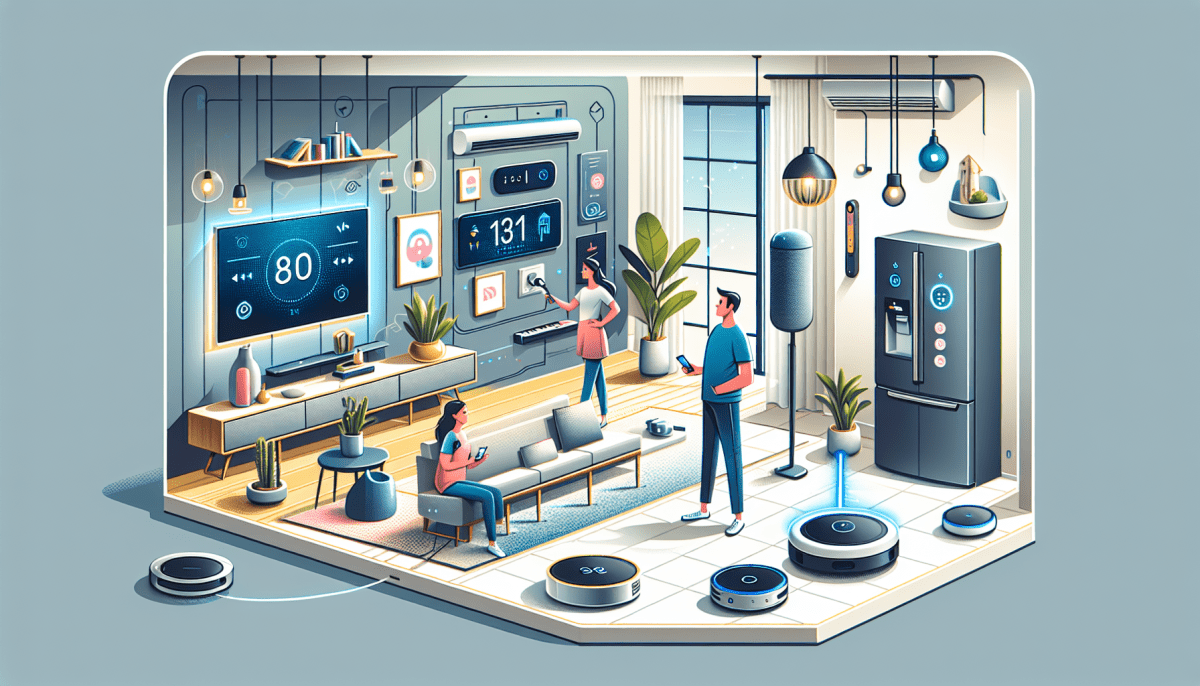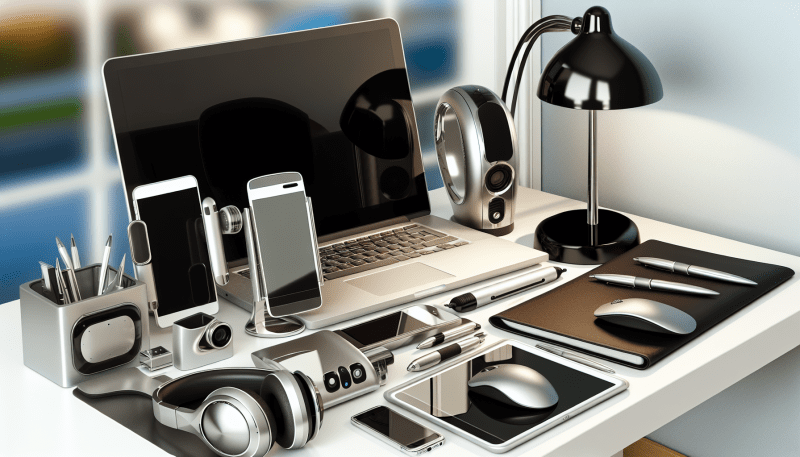Have you ever felt frustrated with a smart device that doesn't seem smart at all? Well, when various features of smart home devices work well together, these devices truly become efficient.
This article will discuss how combining different functions makes smart homes more effective. For example, when you can control your lights, thermostat, and security system all with your voice, it saves time and makes life easier.
We will also look at how these connected features can improve home security, ensuring that our smart devices are useful and not just costly decorations.
Key Takeaways
- Integrating diverse features in smart home devices leads to a seamless user experience.
- It enhances energy efficiency by boosting the overall efficiency of the devices.
- The integration ensures compatibility and interoperability between different devices, allowing for easy control and troubleshooting.
- It enables innovations in remote access and control, providing convenience to users.
Voice Control Integration
We've observed that integrating voice control into smart home devices significantly amplifies their efficiency, allowing users to operate multiple systems with simple verbal commands. This intuitive interface transcends the traditional manual inputs, providing a seamless and hands-free experience.
Our industry's push towards innovation has made gesture commands and user customization paramount, tailoring interactions to individual preferences and accessibility needs.
Incorporating these capabilities, we ensure that our smart home solutions respond to vocal instructions and recognize specific user gestures, creating a multi-modal command environment. This level of personalization and ease of use propels the smart home industry forward, setting a new benchmark for what consumers expect in terms of interactivity and adaptability within their living spaces.
Advancing Home Automation
Building on these personalized control methods, we're now enhancing home automation by integrating systems that learn from user behaviour to streamline daily routines.
By harnessing machine learning algorithms, our smart home devices can predict and adjust to the occupants' needs with remarkable precision, ensuring optimal comfort and energy efficiency.
This predictive capability is made possible through sensor fusion, which combines data from various sources such as temperature, light, and motion sensors, providing a comprehensive understanding of the environment.
As we fine-tune these systems, we see a significant reduction in user-required interventions. Integrating these advanced technologies positions us at the forefront of the smart home industry, delivering solutions that aren't only intuitive and adaptively proactive.
Ensuring Device Compatibility
Ensuring that your smart home devices can work together is key to a smooth-running home. To make this happen, we use universal rules for device communication. This way, you can buy a speaker from one brand and a smart fridge from another, and they'll get along just fine.
It's important because it means less stress for you and more possibilities for what your smart devices can do together. For example, your speaker can tell your fridge to make more ice for a party—all without you needing to figure out complicated setups or have devices from just one company.
Cross-Platform Interoperability
While integrating smart home devices, we must ensure that they're compatible across various platforms to streamline their collective efficiency. Ecosystem fragmentation has long challenged the smart home industry, creating silos that impede the seamless experience users crave.
To address this, we focus on:
-
Developing platform-agnostic solutions that function reliably regardless of the underlying operating system or ecosystem.
-
Establishing open communication protocols that enable devices from different manufacturers to interact effortlessly.
-
Implementing robust APIs that allow for the creation of custom integrations, enriching the functionality and user experience.
Standardized Communication Protocols
Frequently, our discussions center on standardized communication protocols' critical role in ensuring that different smart home devices can interact seamlessly. Protocol uniformity is essential for achieving efficient inter-device connectivity within the smart home ecosystem. Devices sharing standard protocols can communicate without additional bridging software or hardware, simplifying the user experience and reducing latency.
We recognize that adopting universally accepted protocols such as Zigbee, Z-Wave, or the more recent Matter standard can greatly enhance device compatibility. It allows for a more streamlined and interoperable network where devices from different manufacturers can work together without compatibility issues.
This uniform approach to communication ensures that innovation in the smart home space continues to thrive, driven by a foundation of seamless connectivity.
Seamless User Experience
Smart home ecosystems benefit immensely when device compatibility is prioritized, providing us with a frictionless and intuitive user experience. By ensuring a seamless interaction among devices, we can leverage the full potential of a truly connected home.
Here's how we achieve this:
-
We develop user-centered design principles that focus on the needs and preferences of the end-user, ensuring easy navigation and control.
-
Customization options are integral, allowing users to tailor their smart home behavior to fit their unique lifestyle.
-
We insist on interoperability across different manufacturers, facilitating a cohesive network of devices that work in unison.
Our commitment to these standards not only enhances functionality but also ensures that innovation continues to thrive within the smart home industry, delivering a user experience that's both sophisticated and accessible.
Boosting Energy Efficiency
Our pursuit of sustainability has led to integrating energy management features in smart home devices, significantly reducing power consumption. Utilizing smart meters and energy monitoring systems, we've made substantial strides in the quest for energy efficiency. These technologies provide granular insights into power usage, allowing for the optimization of energy consumption patterns across various devices.
| Feature | Benefit | Smart Device Integration |
|---|---|---|
| Smart meters | Real-time energy usage data | Thermostats, Appliances |
| Energy monitoring | Identify inefficiencies | Lighting, Security Systems |
| Automated control | Adjust settings for savings | HVAC, Entertainment Systems |
| Predictive maintenance | Prevent energy waste | Refrigerators, Washers |
We're committed to continuously refining these integrations, ensuring that our smart home solutions remain at the forefront of innovation, catering to an audience that demands cutting-edge, sustainable technology.
Reinforcing Security Features
We've also enhanced our smart home ecosystems with advanced security features that deter intruders and provide homeowners with peace of mind. Implementing these sophisticated measures is crucial in an era where digital security is paramount. Here's how we're revolutionizing home safety:
-
Smart Locks: We've integrated cutting-edge smart locks that offer remote access control, ensuring that only authorized individuals can enter.
-
Biometric Authentication: Our systems use biometric authentication, including fingerprint and facial recognition, for a personalized and nearly impenetrable layer of security.
-
Real-Time Alerts: Homeowners receive instant notifications for any unusual activity, allowing for swift responses to potential security breaches.
Each innovation reflects our commitment to providing a seamless, secure smart home experience that aligns with the latest technological advancements.
Innovations in Remote Access
Beyond security, we're expanding functionality with remote access innovations that allow homeowners to manage their smart homes from anywhere. Embracing the latest in connectivity, we've enabled seamless control over devices, ensuring users can adjust settings, monitor energy usage, and receive real-time notifications. This level of access isn't just about convenience; it's about fostering a responsive and adaptable smart home environment.
Key to this evolution is the integration of remote troubleshooting capabilities, allowing for swift diagnosis and resolution of issues without requiring a technician's physical presence. Moreover, we've streamlined the deployment of firmware updates, ensuring that devices remain up-to-date with the latest features and security enhancements. This proactive approach to maintenance significantly reduces downtime and enhances overall system reliability.
Our Final Thoughts
Smart Home Devices are the ultimate Gadgets for the home, and adding different features to smart home technology makes our homes work better and saves us time. For example, we can easily control all our devices without lifting a finger when we use voice commands.
It's essential that these devices can work together; this makes sure everything runs smoothly.
Saving energy and keeping our homes safe are big benefits, too. We can control things like lights and locks from anywhere, which is really convenient.
All of these improvements are making our homes smarter and shaping the future in exciting ways.



